Submitted:
09 November 2023
Posted:
09 November 2023
You are already at the latest version
Abstract
Keywords:
0. Introduction
1. Building-Type IES and PMV Index
1.1. IES Model
1.2. PMV Index for Building Indoor Somatosensory Comfort
2. Optimization Model for Building-Type IES Planning and Capacity Sizing
2.1. Preprocessing
2.2. Optimization Objective
2.3. Constrains
2.4. Model Solution
3. Case Studies
3.1. Basic Settings
3.2. Scenario Analysis without PV Modules
3.3. Scenario Analysis with PV Modules
3.4. Power Balance Study
4. Sensitivity Analysis
4.1. Ggas Price
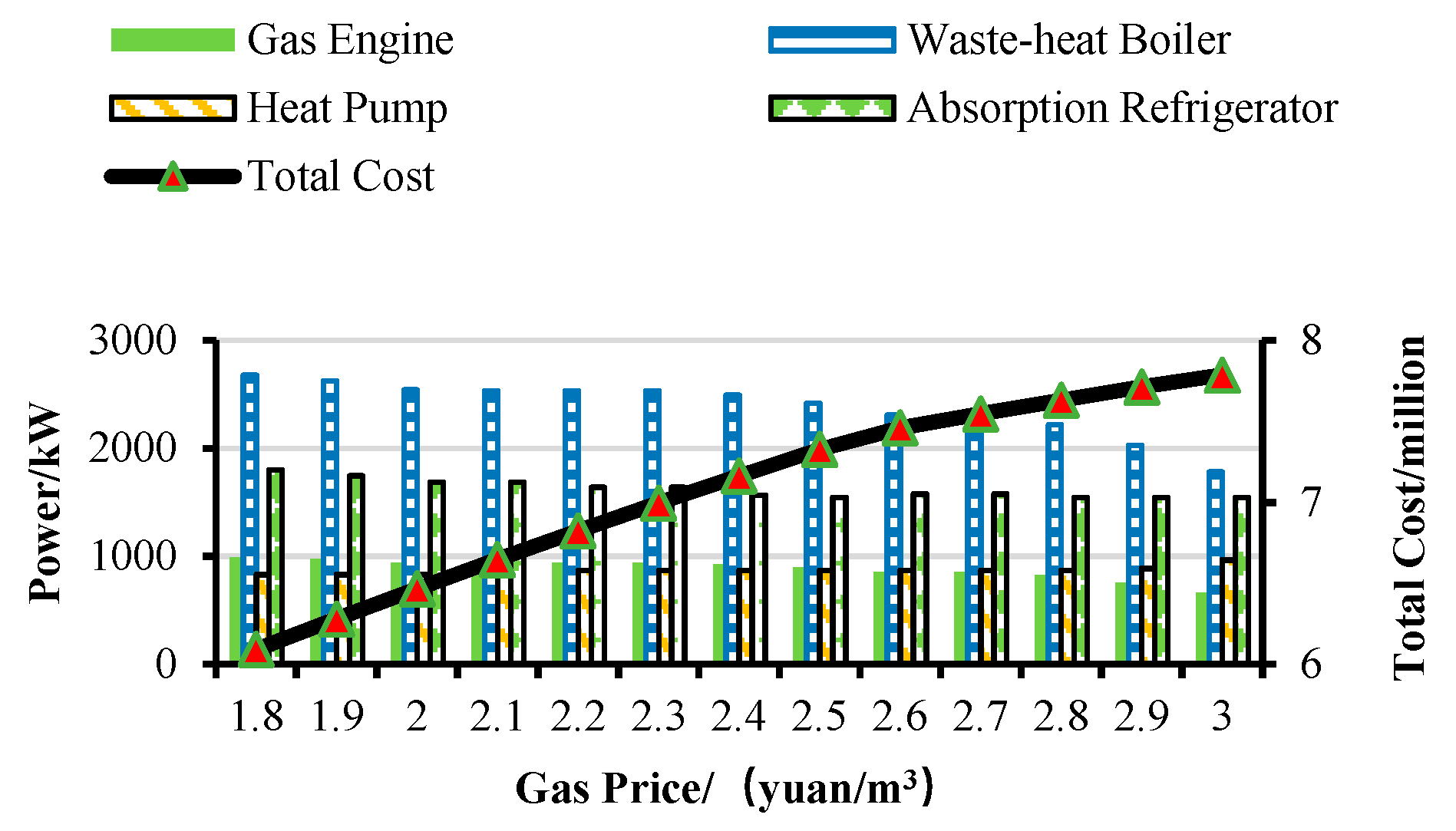
4.2. Peak-Valley Price Gap of Grid Supplied Power
5. Conclusions
Acknowledgments
Conflicts of Interest
Appendix A. Parameters
A1. Economic Parameters of the Equipment
| Devices | Abbreviation | Average life/year | Minimum load rate | Maximum load rate | Unit installation capacity cost/ RMB yuan | Electric efficiency | Thermal efficiency | Coefficient of performance |
|---|---|---|---|---|---|---|---|---|
| Gas engine | MT | 30 | 0.2 | 1 | 6000 | 0.25 | — | — |
| Waste-heat boiler | WH | 20 | 0 | 1 | 125 | — | 0.9 | — |
| Gas-fired boiler | GB | 15 | 0 | 1 | 340 | — | 0.93 | — |
| Heat pump | HP | 10 | 0 | 1 | 971 | — | — | 4.5 |
| Absorption refrigerator | AC | 20 | 0 | 1 | 1100 | — | — | 0.85 |
| Electric refrigerator | EC | 20 | 0 | 1 | 3000 | — | — | 0.95 |
| Electrical energy storage | ES | 10 | 0.2 | 0.8 | 2000 | 0.95 | — | 0.2 |
| Thermal energy storage | HS | 10 | 0.1 | 0.9 | 150 | — | 0.9 | 0.2 |
| Photovoltaic module | PV | 20 | — | — | 7000 | 0.95 | — | — |
A2. Indoor Temperature Constraint Parameters
| Category | Parameter | Value |
|---|---|---|
| PMV index parameters | Cl1 | 0.155 m2·°C/W |
| Cl2 | 0.067 m2·°C/W | |
| Cl3 | 0.251 m2·°C/W | |
| M | 58.2 W/m2 | |
| Building parameters | R | 1.5 °C/kW |
| C | 5.44 kWh/°C |
A3. Power Purchase and Sale Price Curve
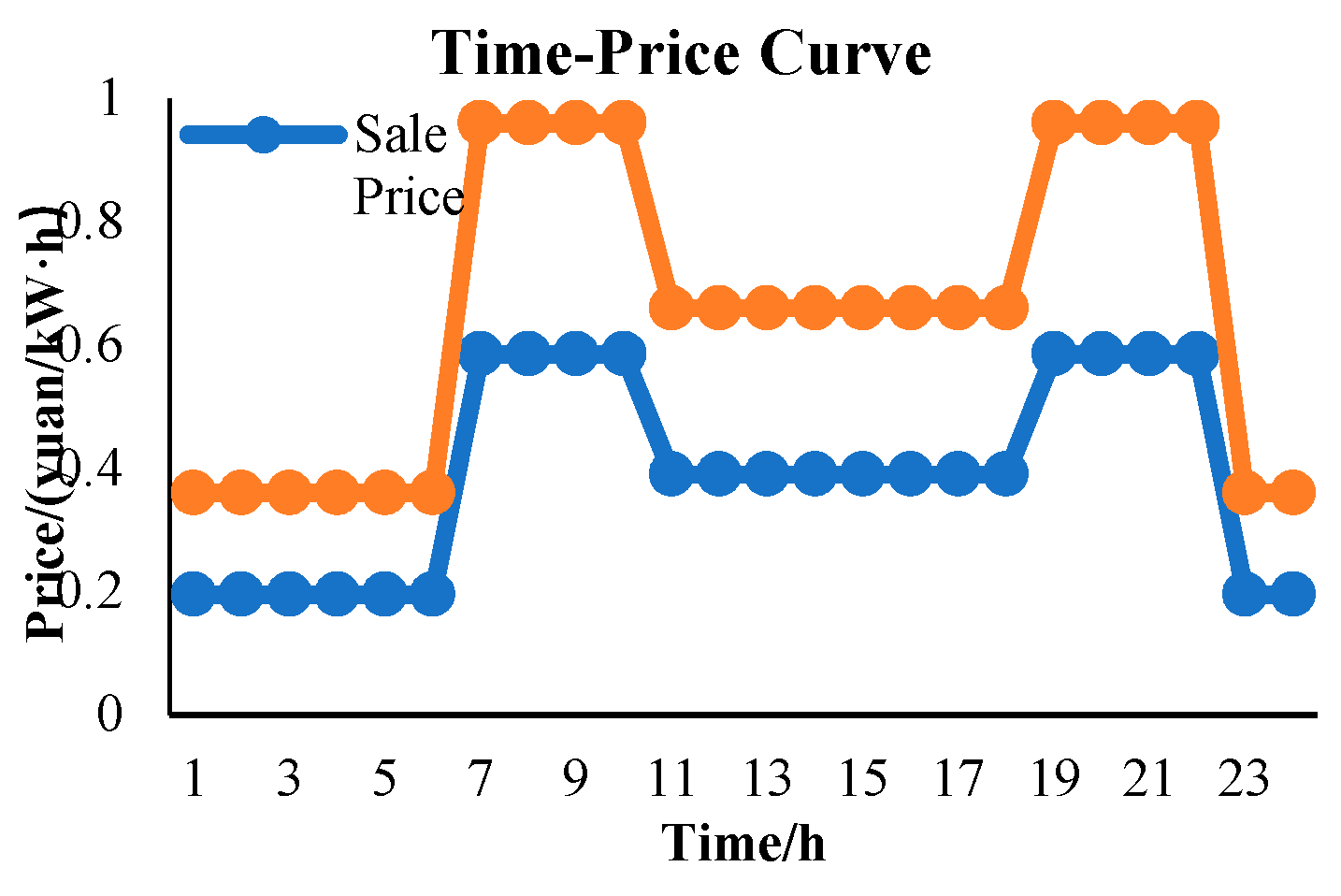
A4. Typical Daily Rigid Electric Heating Load and Outdoor Temperature
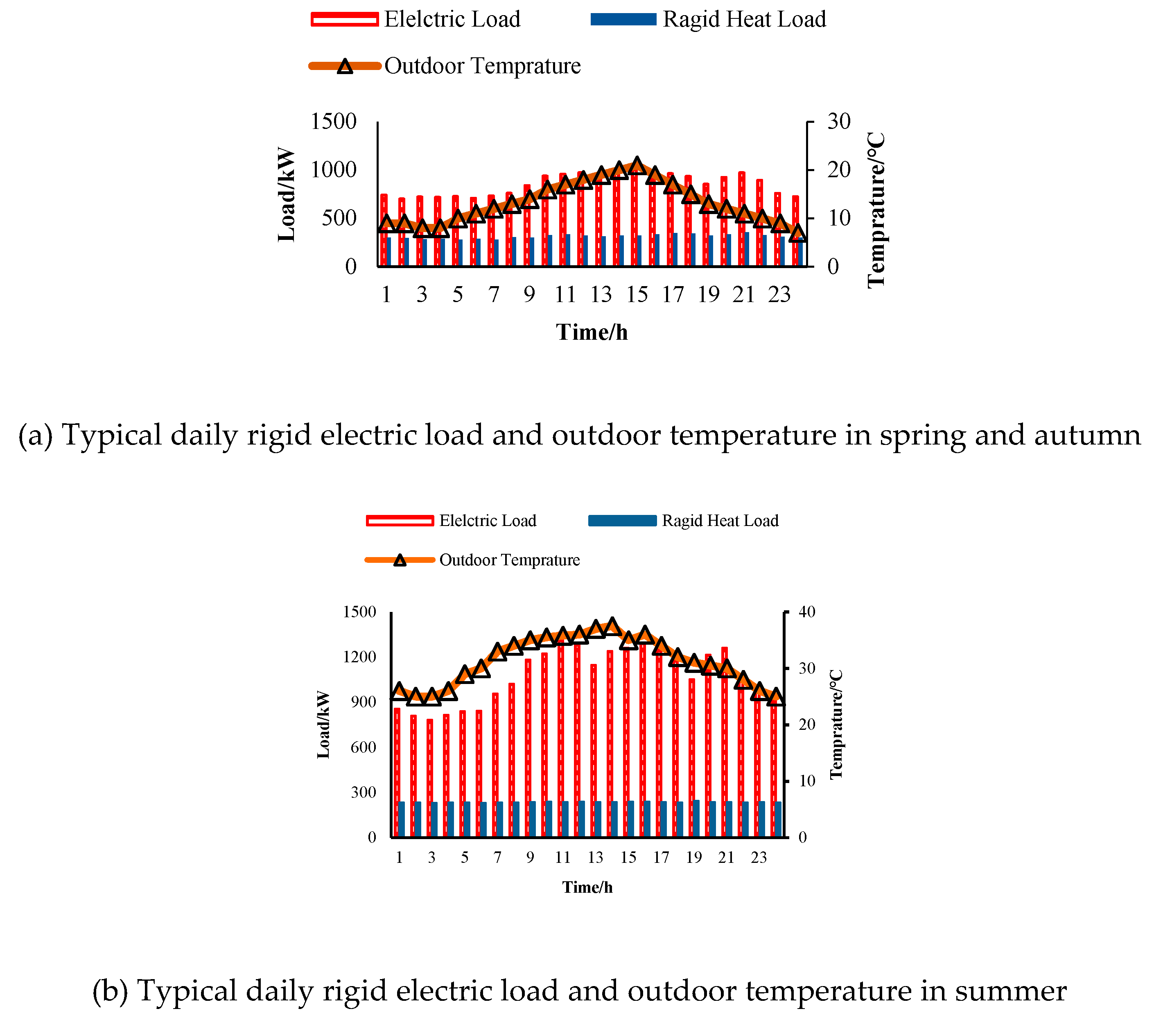
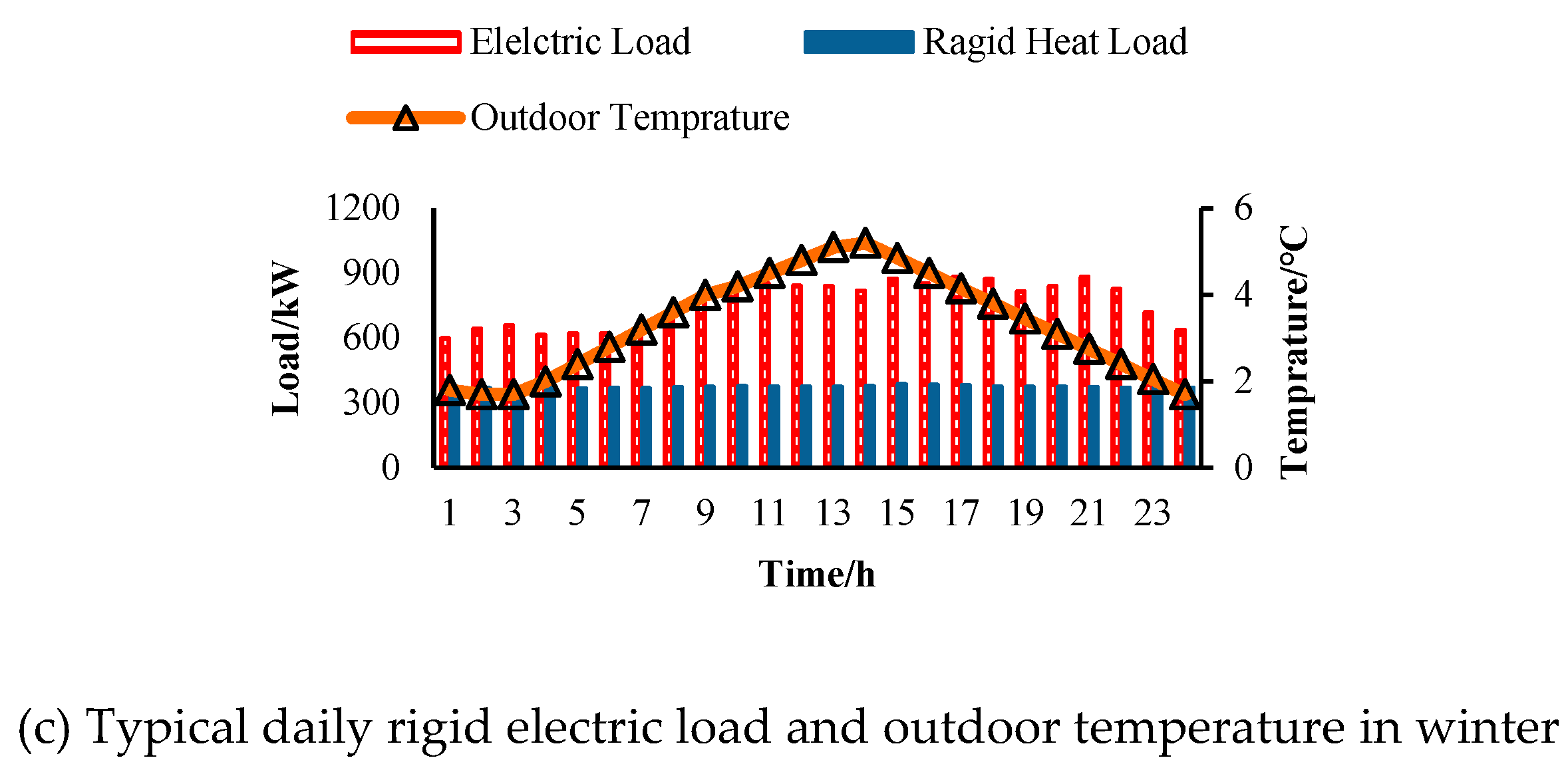
References
- Chen, C.; Liu, S.; Lin, Z. Optimal coordinative operation strategy of the electric-thermal-gas integrated energy system considering CSP plant. IET Energy Systems Integration. 2020, 3, 187–195. [Google Scholar] [CrossRef]
- Yin Y; Liu Y; Ma, Y; Lei Y. Integrated energy demand forecasting for the park based on the Transformer algorithm. Integrated intelligent Energy. 2023, 10, 61–69.
- Mancarella, P; Chicco, G. Demand response from energy shifting in distributed multi-generation. IEEE Trans. Smart Grid. 2013, 19, 28–38.
- Deng, Z; Yang, J; Dong, C. et al. Research on economic dispatch of integrated energy system based on improved krill swarm algorithm. Energy Reports. 2022, 8, 77–86. [CrossRef]
- Zhang, X; Karady, G; Ariaratnam,S. Optimal allocation of CHP-based distributed generation on urban energy distribution networks. IEEE Trans. Sustain. Energy. IEEE Trans. Sustain. Energy. 2014, 2, 46–53.
- Ren,S; Hu, B; Ning, L. et al. Optimal operation of integrated energy system including large-scale controllable industrial loads. Energy Reports. 2022, 8, 938–949. [CrossRef]
- Fu, Y; Sun, Q; Wennersten, R. The effect of correlation of uncertainties on collaborative optimization of integrated energy system. Energy Reports. 2021, 7, 586–592. [CrossRef]
- Huang, W; Zhang, N; Yang, J; Wang, Y; Kang, C. Optimal configuration planning of multi-Energy systems considering distributed renewable Energy. IEEE Trans. Smart Grid. 2019, 14, 52–64.
- Zhou, Z; Liu, P; Li, Z; Ni, W. An engineering approach to the optimal design of distributed energy systems in China. Appl. Therm. Eng. 2013, 3, 87–96.
- Oh, S; Lee, H; Jung, J; Kwak, H. Optimal planning and economic evaluation of cogeneration system. Energy. 2007, 7, 60–71.
- Wu, C; Tang, W; Bai, M; Zhang, L; Cai, Y. Energy router based planning of energy internet at user side. Automation of Electric Power Systems. 2017, 4, 20–28.
- Bahrami, S; Safe, F. A financial approach to evaluate an optimized combined cooling, heat and power system. Energy and Power Engineering. 2013, 3, 52–62.
- Karami, H; Sanjari, M; Hosseinian, S; Gharehpetian, G. An optimal dispatch algorithm for managing residential distributed energy resources. IEEE Trans. Smart Grid. 2014, 5, 2360–2367. [CrossRef]
- Dou, X; Shao, Y; Wang, J; Hu Q. Heat-electricity joint bidding strategies for intelligent buildings in intelligent building cluster. International Journal of Electrical Power & Energy Systems. 2021, 129, 1–11.
- Zhao, F; Zhang, C; Sun, B; Wei, D. Three-stage collaborative global optimization design method of combined cooling heating and power. Proceedings of the CSEE. 2015, 37, 85–93.
- Salimi, M; Ghasemi, H; Adelpour, M; Vaez-Zadeh, S. Optimal planning of energy hubs in interconnected energy systems: a case study for natural gas and electricity. IET Generation, Transmission & Distribution. 2015, 9, 695–707.
- Liu, D; Wu, J; Lin, K; L, D; Gong, T. A planning method of integrated energy system based on kriging model. Power System Technology. 2019, 1, 85–94.
- Sheikhi, A; Rayati, M; Ranjbar, A. Energy Hub optimal sizing in the smart grid: machine learning approach. IEEE Power&Energy Society Innovative Smart Grid Technologies Conference. 2015, 1-5.
- Arcuri, P; Florio, G; Fragiacomo, P. A mixed integer programming model for optimal design of trigeneration in a hospital complex. Energy. 2010, 14, 30–47.
- Lara, E; Garcia, F. Review on viability and implementation of residential PV-battery systems: considering the case of dominican republic. Energy Reports 2021, 7, 8868–8899. [CrossRef]
- Zhao, W; Chen, J; Hai, T. et al. Design of low-energy buildings in densely populated urban areas based on IoT. Energy Reports 2022, 8, 4822–4833. [CrossRef]
- Solano, J; Olivieri, L; Caamaño-Martín, E. Sing the potential of PV hybrid systems to cover HVAC loads in a grid-connected residential building through intelligent control. Applied Energy. 2017, 2, 49–66.
- Brahman, S; Honarmand, M; Jadid, S. Optimal electrical and thermal energy management of a residential energy hub integrating demand response and energy storage system. Energy and Buildings. 2015, 90, 65–75. [CrossRef]
- Sheikhi, A; Rayati, M; Bahrami, S; Ranjbar, A. Integrated demand side management game in smart energy hubs. IEEE Trans. Smart Grid. 2015, 6, 75–83.
- Tasdighi, M; Ghasemi, H; Rahimi-Kian, A. Residential microgrid scheduling based on smart meters data and temperature dependent thermal load modeling. IEEE Trans.Smart Grid. 2014, 3, 49–57.
- Mei, X; Song, M. An autonomous hierarchical control for improving indoor comfort and energy efficiency of a direct expansion air conditioning system. Applied Energy. 2018, 4, 50–63.
- Westner, G; Madlener, R. Investment in new power generation under uncertainty: benefits of CHP vs. condensing plants in a copula based analysis. Energy Econ. 2012, 34, 31–44. [CrossRef]
- Sheikhi, A; Ranjbar, A; Oraee, H. Financial analysis and optimal size and operation for a multicarrier energy system. Energy and Buildings. 2012, 7, 7,1–8.
- Rienze, F; Ahcin, P; Andersson, G. Valuing investments in multi-energy conversion, storage, and demand-side-management systems under uncertainty. IEEE Trans. Sustain. Energy, 2011, 2, 194–202. [CrossRef]
- Ceseña, E; Capuder, T; Mancarella, P. Flexible distributed multi-energy generation system expansion planning under uncertainty. IEEE Trans. Smart Grid. 2016, 3, 48–57.
- Zhang H; Wen, F; Zhang, C; Meng, J; Lin, G; Dang S. Operation optimization model of home energy hubs considering comfort level of customers. Automation of Electric Power Systems. 2016, 20, 32–39.
- Fanger, P. “Thermal comfort "Copenhagen. Denmark: Danish Techical Press . 1970.
- Zeng, G; Tian, Y; Zhao, H; Wang, P. Analysis on the environment and synthesis factors affecting the PMV index. Building Energy Efficiency, 2007, 1, 1–6.
- Zhang, W; Lian, J; Chang, C; Kalsi, K. Aggregated modeling and control of air conditioning loads for demand response. IEEE Trans. Power Systems. 2013, 46, 55–64.
- Li, W; Zhang, H; Wang, Q; Yang, Q. Characteristics of wind power in Jilin province and the study of wind curtailment reduction policy recommendations. Renewable Energy Resources. 2013, 2, 123–126.
- Cui P. Optimal allocation and comprehensive benefit evaluation of energy hubs considering comprehensive demand side response. Hangzhou, China: Zhejiang Univ Press. 2018.
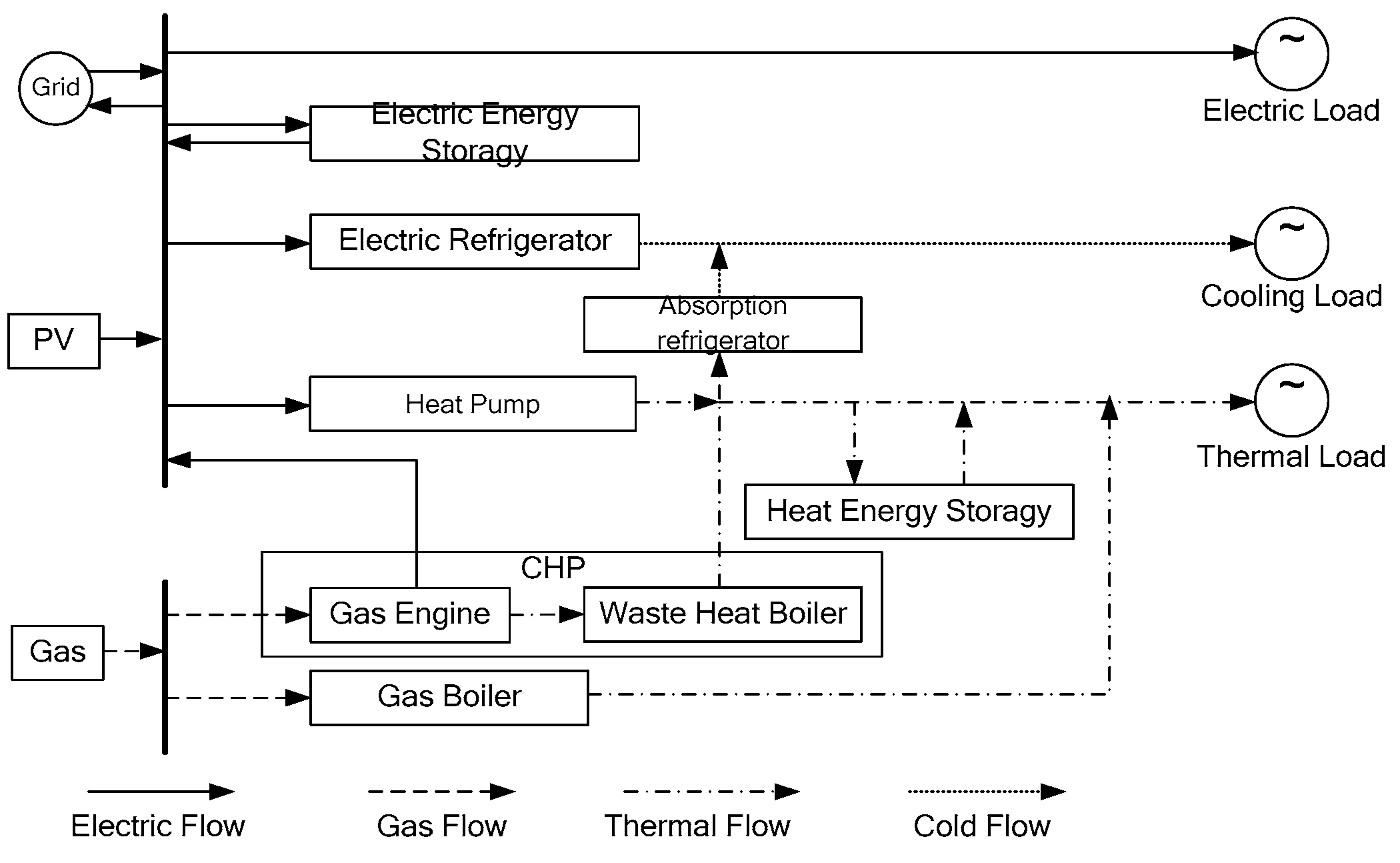
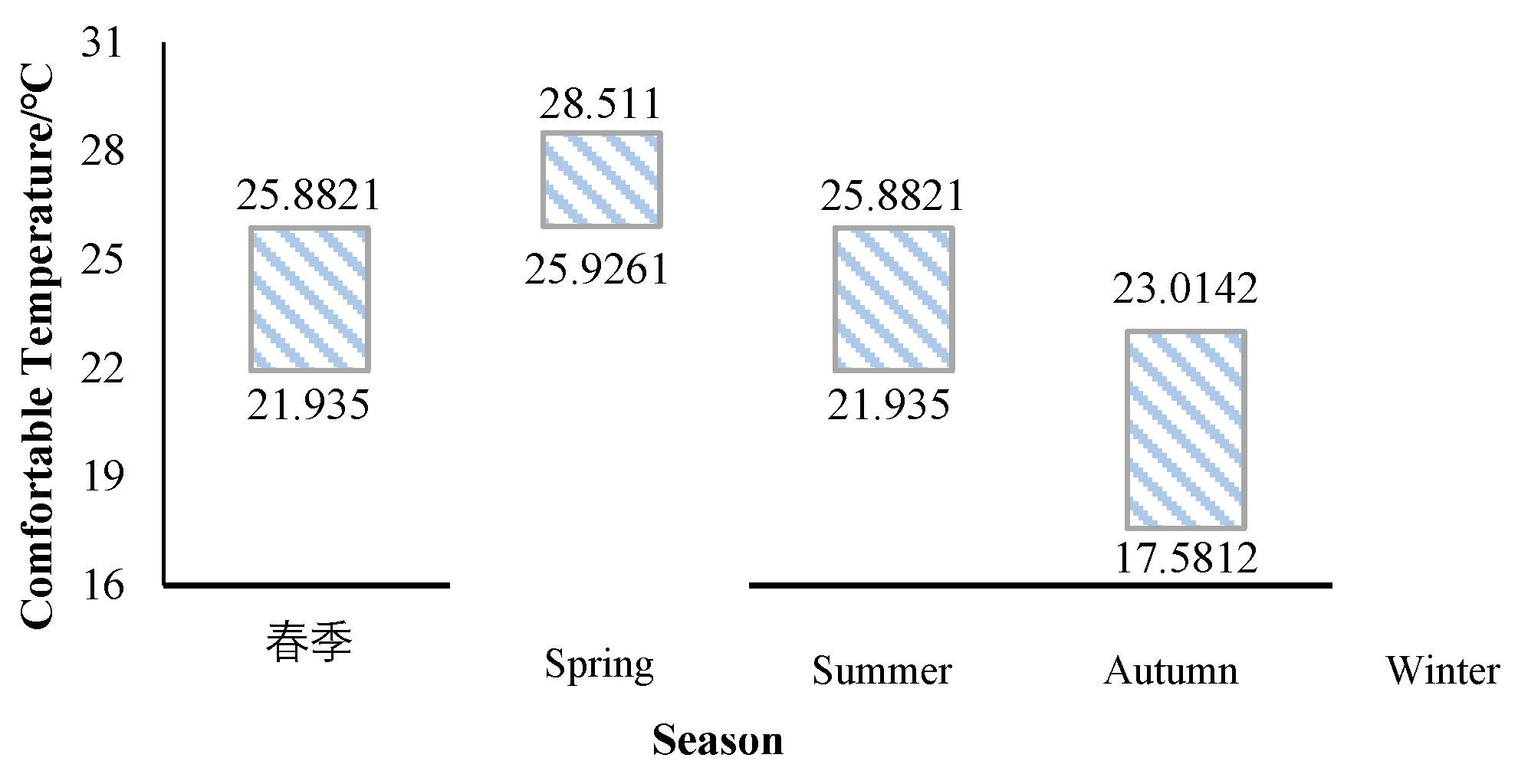
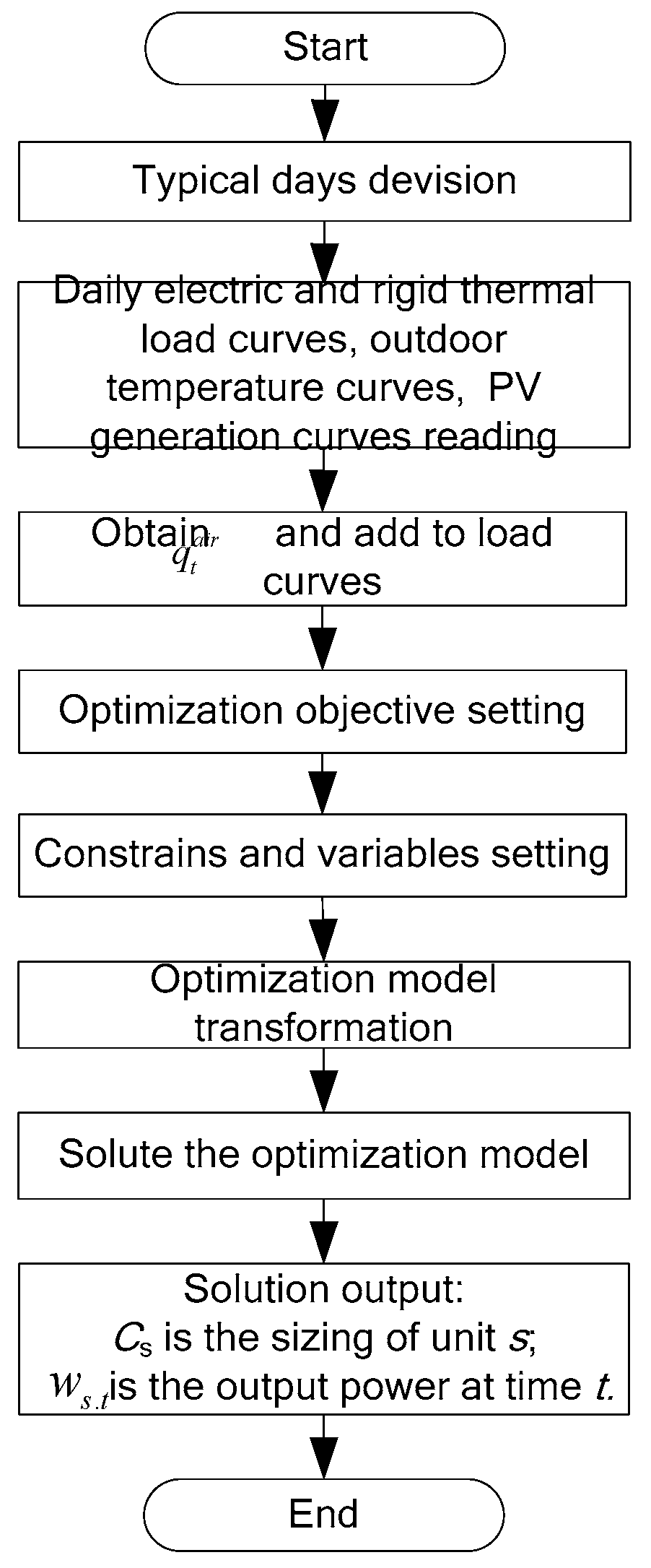
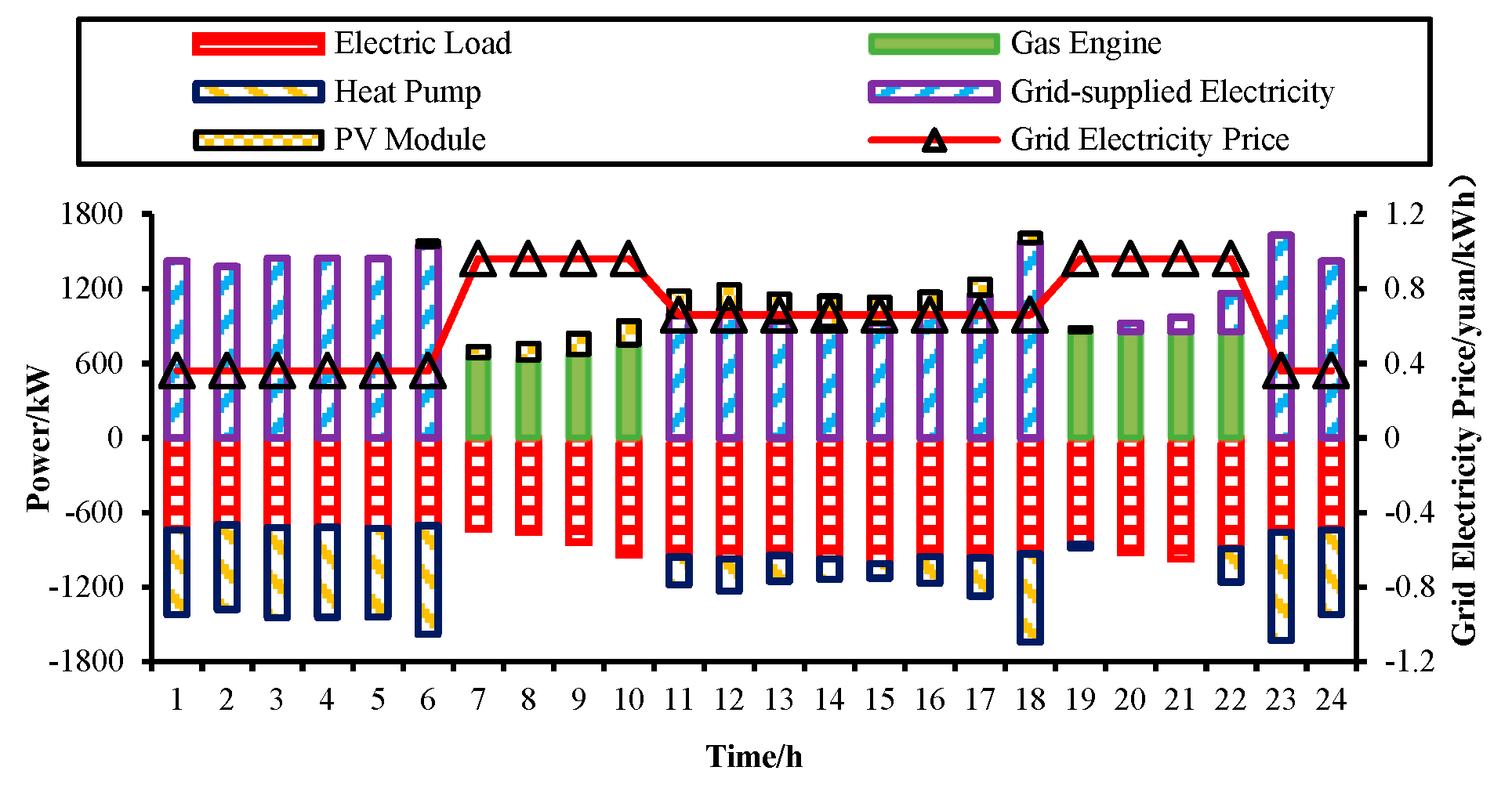
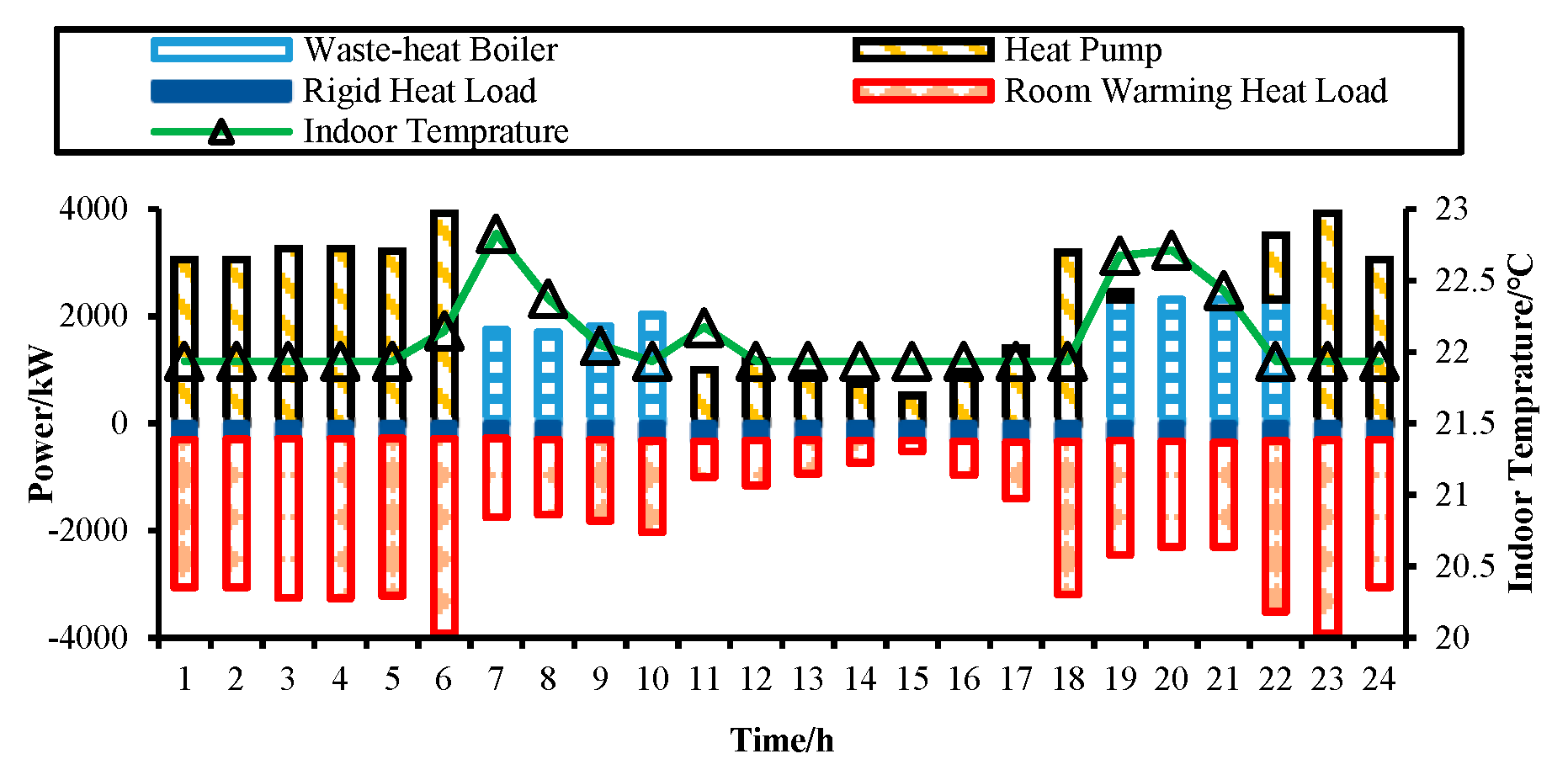
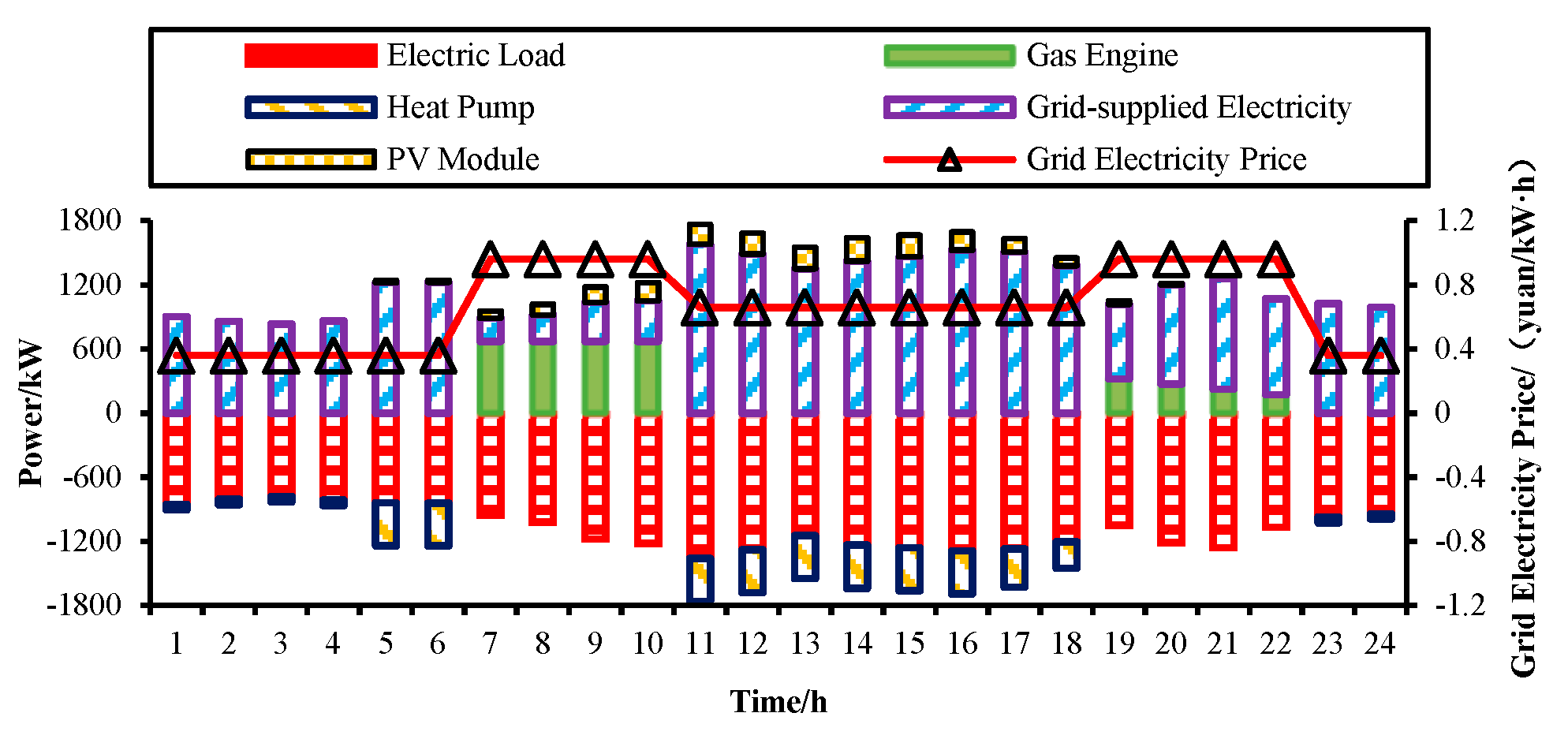
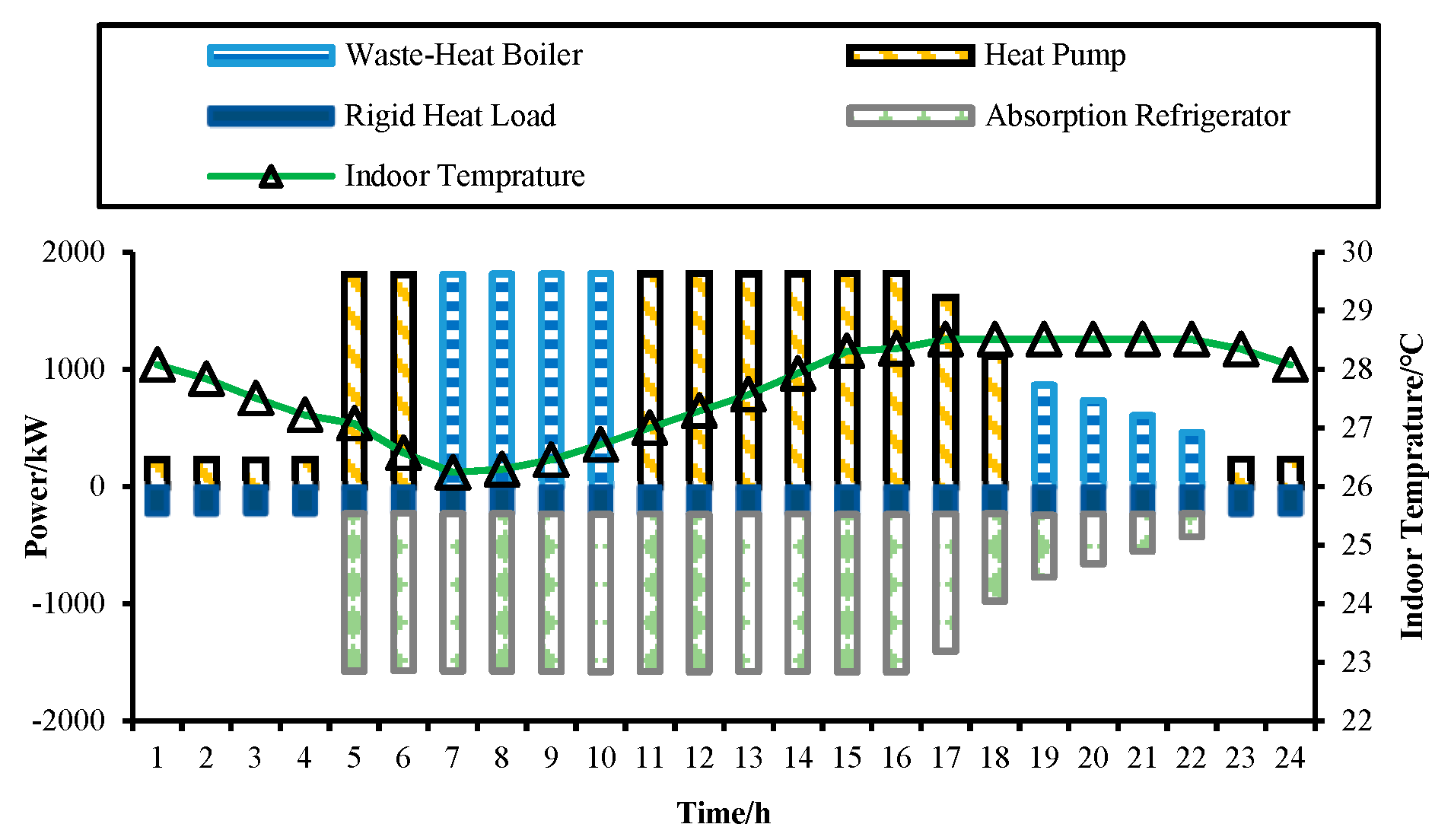
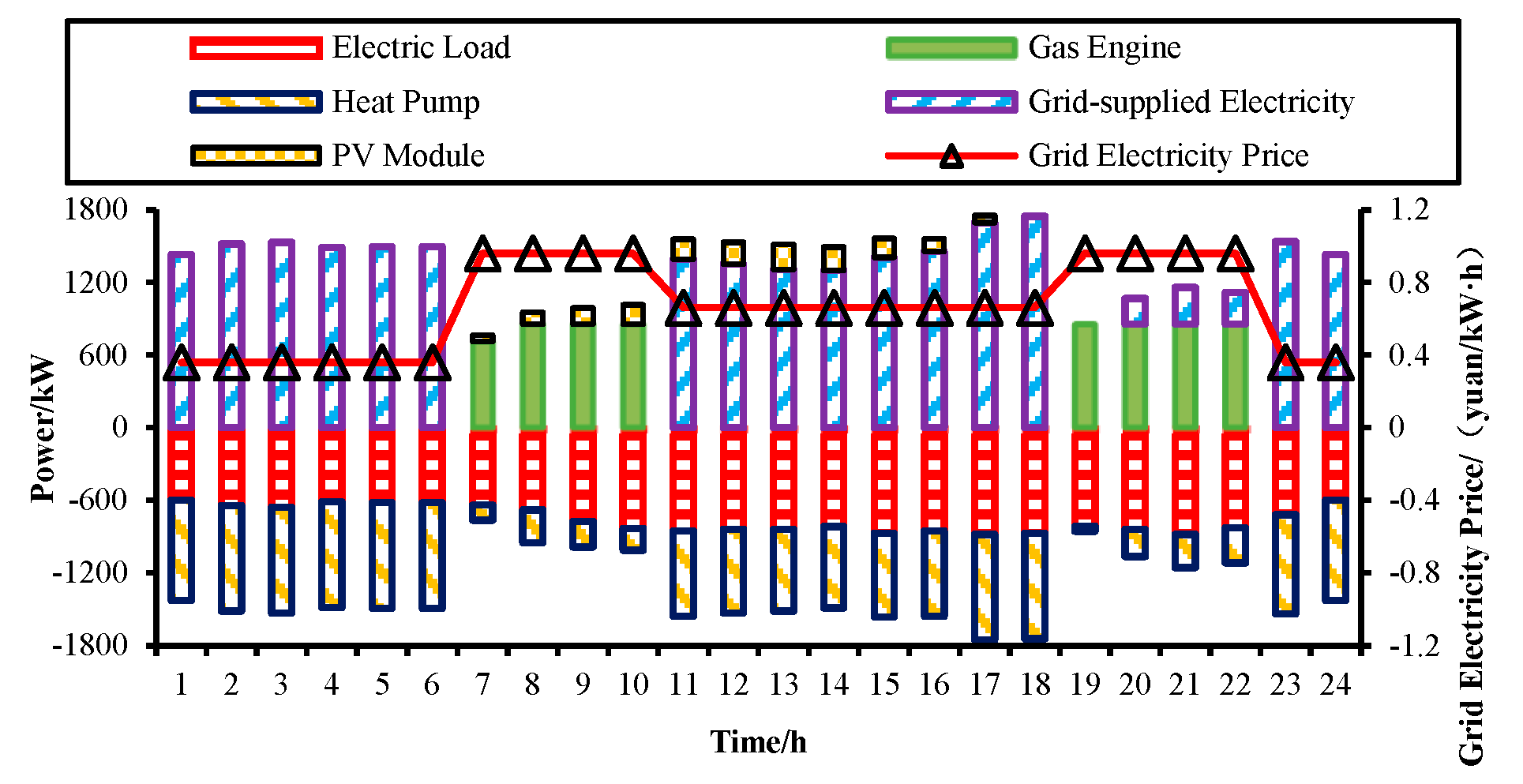
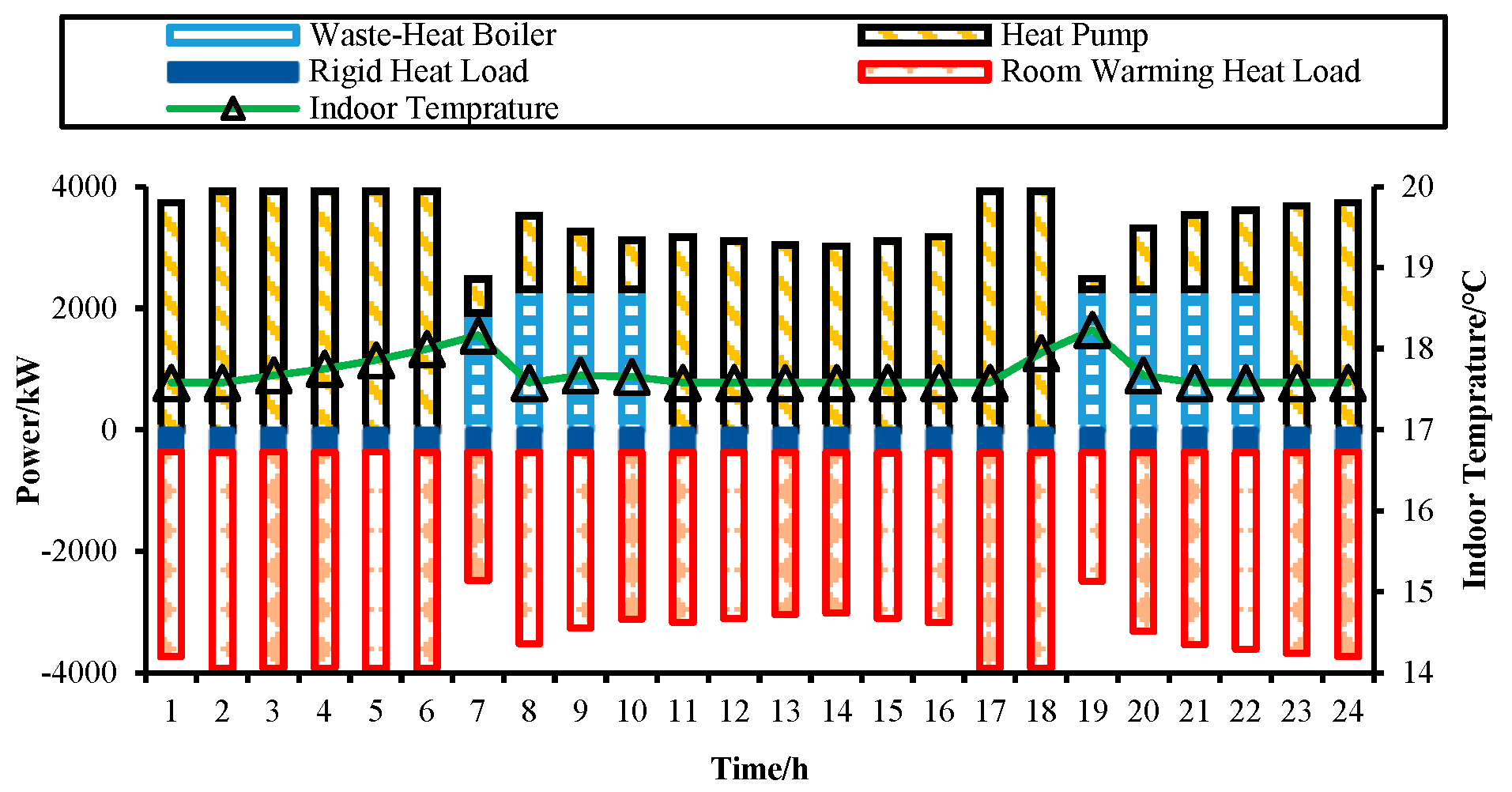

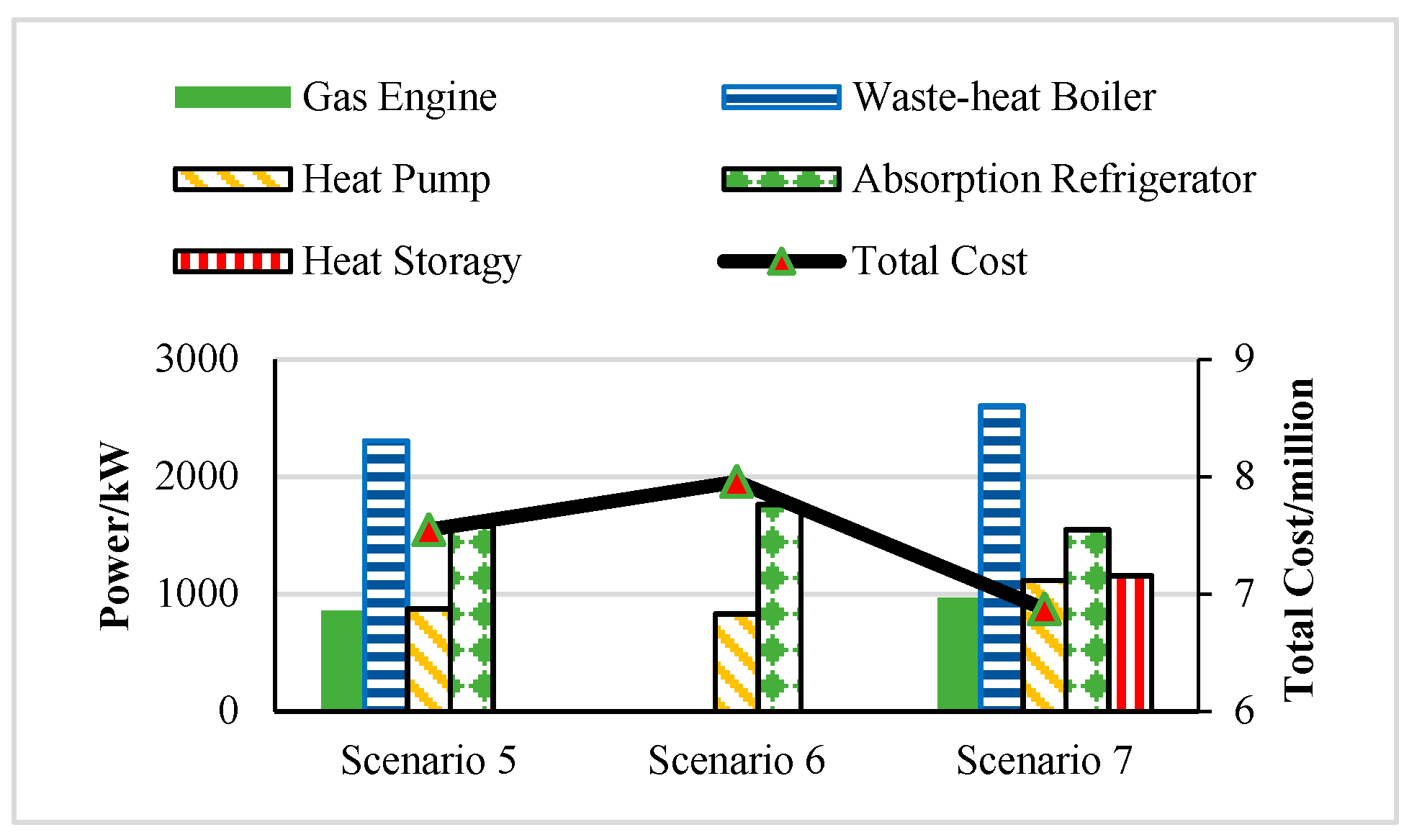
| Scenario | Optimally sized capacity/kW | Thermal storage power/capacity kW/kWh |
|||
|---|---|---|---|---|---|
| Gas engine | Waste- heat boiler |
Heat pump | Absorption refrigerator | ||
| Scenario 1 | 936.7 | 2529.1 | 871.7 | 1579.3 | 0 |
| Scenario 2 | 1299.5 | 3508.7 | 0 | 1579.8 | 1822.6/3645.2 |
| Scenario 3 | 1354.4 | 3656.8 | 0 | 1580.1 | 0 |
| Scenario | Cost/(year 10000 RMB yuan) | Total cost (10,000 RMB yuan/year) | ||
|---|---|---|---|---|
| Installation | Maintenance | Energy fuel consumption | ||
| Scenario 1 | 66.8 | 3.3 | 711.4 | 781.5 |
| Scenario 2 | 78.1 | 3.9 | 870.3 | 952.3 |
| Scenario 3 | 73.3 | 3.7 | 890.4 | 967.4 |
| Scenario | Optimallysized capacity/kW | ||||
|---|---|---|---|---|---|
| Gas engine | Waste-heat boiler | Heat pump | Absorption refrigerator | PV module | |
| Scenario 1 | 936.7 | 2529.1 | 871.7 | 1579.3 | 0 |
| Scenario 4 | 895.7 | 2418.5 | 871.7 | 1579.7 | 150 |
| Scenario 5 | 854.7 | 2307.8 | 871.7 | 1580.1 | 300 |
| Scenario | Cost/(year 10000 RMB yuan) | Total cost (10,000 RMB yuan/year) | ||
|---|---|---|---|---|
| Installation | Maintenance | Energy fuel consumption | ||
| Scenario 1 | 66.8 | 3.3 | 711.4 | 781.5 |
| Scenario 4 | 73.5 | 3.7 | 688.7 | 765.9 |
| Scenario 5 | 80.2 | 4.0 | 666.0 | 750.2 |
Disclaimer/Publisher’s Note: The statements, opinions and data contained in all publications are solely those of the individual author(s) and contributor(s) and not of MDPI and/or the editor(s). MDPI and/or the editor(s) disclaim responsibility for any injury to people or property resulting from any ideas, methods, instructions or products referred to in the content. |
© 2023 by the authors. Licensee MDPI, Basel, Switzerland. This article is an open access article distributed under the terms and conditions of the Creative Commons Attribution (CC BY) license (http://creativecommons.org/licenses/by/4.0/).





